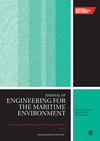Marine diesel engine turbocharger fouling phenomenon risk assessment application by using fuzzy FMEA method
IF 1.5
4区 工程技术
Q3 ENGINEERING, MARINE
Proceedings of the Institution of Mechanical Engineers, Part M: Journal of Engineering for the Maritime Environment
Pub Date : 2023-11-14
DOI:10.1177/14750902231208848
引用次数: 0
Abstract
Turbocharger fouling phenomenon was analyzed from the risk assessment perspective in this study. The research employed exhaust system and turbocharger equipment of commercial ship that equipped with a Doosan-MAN B&W 6S50 MC-C diesel engine was used as the main research materials, and utilized the fuzzy Failure Mode and Effects Analysis (FMEA) based on the expert system as a methodical approach. The experts revealed different types of turbocharger fouling failure modes (FMs), along with their respective causes and subsequent consequences. Following that, the specialists allocated an O, S, and D score to each FM. Within the framework of fuzzy logic, the process entails the establishment of input and output membership functions, as well as the construction of a fuzzy model incorporating an inference mechanism and a rule base. Based on the analysis findings, the three primary factors are as follows: low cylinder compression pressure with a Fuzzy Risk Priority Number (FRPN) score of 6.95, high main engine fuel oil consumption with a score of 6.92, and high CO, CO 2 , SO x emissions with a 6.45. The phenomenon of turbocharger fouling, being an inherent occurrence, has significant ramifications on the main engine, the vessel as a whole, and the ecological surroundings. The quantitative results presented in this study provide valuable insights into the risks associated with maritime endeavors. The data generated from this research can be used by stakeholders in the maritime industry to better understand this situation and take proactive measures to mitigate potential risks in the future. Furthermore, the findings of the research provide corroboration for the implementation of predictive maintenance procedures.应用模糊FMEA方法对船用柴油机涡轮增压器污垢现象进行风险评价
本研究从风险评估的角度对涡轮增压器结垢现象进行分析。本研究以Doosan-MAN B&W 6S50 MC-C型柴油机的商船排气系统和涡轮增压器设备为主要研究材料,采用基于专家系统的模糊失效模式和影响分析(FMEA)作为方法。专家们揭示了不同类型的涡轮增压器污垢失效模式(FMs),以及它们各自的原因和随后的后果。随后,专家们给每个FM分配了0、S和D分。在模糊逻辑框架内,该过程需要建立输入和输出隶属函数,以及构建包含推理机制和规则库的模糊模型。根据分析结果,三个主要影响因素为:气缸压缩压力低,模糊风险优先数(FRPN)评分为6.95;主机燃油消耗量高,评分为6.92;CO、CO 2、SO x排放高,评分为6.45。增压器结垢现象是一种固有现象,对主机、整机和生态环境都有重大影响。本研究中提出的定量结果为与海事活动相关的风险提供了有价值的见解。海运业的利益相关者可以使用本研究产生的数据来更好地了解这种情况,并采取积极措施来减轻未来的潜在风险。此外,研究结果为预测性维护程序的实施提供了佐证。
本文章由计算机程序翻译,如有差异,请以英文原文为准。
求助全文
约1分钟内获得全文
求助全文
来源期刊

CiteScore
3.90
自引率
11.10%
发文量
77
审稿时长
>12 weeks
期刊介绍:
The Journal of Engineering for the Maritime Environment is concerned with the design, production and operation of engineering artefacts for the maritime environment. The journal straddles the traditional boundaries of naval architecture, marine engineering, offshore/ocean engineering, coastal engineering and port engineering.
 求助内容:
求助内容: 应助结果提醒方式:
应助结果提醒方式:


